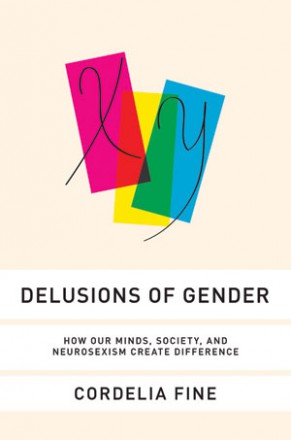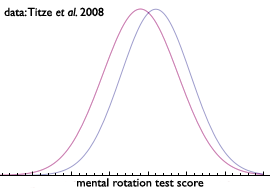 Delusions of Gender by Cordelia Fine is an example of that rare science book that sets me on a new way of thinking. That’s not to say I found it perfect — there is much to disagree with between its covers, some of which I will abstract here — but for framing and displaying the Big Questions that guide us as scientists, it has few parallels.
Delusions of Gender by Cordelia Fine is an example of that rare science book that sets me on a new way of thinking. That’s not to say I found it perfect — there is much to disagree with between its covers, some of which I will abstract here — but for framing and displaying the Big Questions that guide us as scientists, it has few parallels.
It seems the only uninterrupted (read: Internet-free) time I have to read is on airplanes. The time between boarding and achieving cruising altitude, and the mirror-image process of landing, is a time that all electronic devices are stowed, and therefore a perfect time for an old-fashioned, paper and pasteboard book.
I was sitting on the plane to Seattle, engaging in my usual practice of “eavesdropping” on what the person to my right was reading.
It was the book Bringing Up Boys by James Dobson. The passage at the top of the page he was reading (page 15, to be precise) said:
“Think for a moment about the above quotes from Steinem, Greer, and the other early feminists. Most of them were never married, didn’t like children, and deeply resented men, yet they advised millions of women on how to raise their children and, especially, how to produce healthy boys. There is no evidence that Steinem or Greer ever had any significant experience with children of either sex. Isn’t it interesting that the media (to my knowledge) never homed in on that incongruity? And isn’t it sad that these women were allowed to twist and warp the attitudes of a generation of kids?”
What I was reading was like a sort of Ode on a Grecian Urn of Nonsense, a perfection in stupidity. How did Dobson know that early feminists “deeply resented men” and “didn’t like children”? That damn mainstream media dropped the ball again, by refusing to expose the perfidy of people fighting for basic human rights. I’m not even sure what the evidence is for either Steinem or Greer “advis[ing] millions of women on how to raise children”. Sure, I know they wrote on the subject, but as an adolescent at the time, I don’t recall a lot of my peers’ parents following Greer’s advice to raise us like Tahitians. I don’t recall a single lavalava being worn to classes in my high school.
Meanwhile, over in the book I was pretending to read at the time, Delusions of Gender, I could have been reading how a miniscule amount of neuroscience had been turned into a defense and bolstering of Dobson’s moss-backed attitude towards sex roles.
Fine takes issue with the current crop of “Men Are From Mars, Women Are From Venus” books, that claim an innate, immutable set of talents which are possessed by Y chromosome owners as a result of the bathing of brain cells in testosterone in utero. Of course, such books also claim that bathing brain cells in estrogen produces the exact opposite effects: active vs passive, destroying vs nurturing, even folding maps properly vs being charmingly unable to use a map. One can almost hear Rex Harrison as Prof. Henry Higgins singing “Why Can’t a Woman Be More Like a Man?” whilst reading these horrid books.
Fine needs no reductio ad absurdum to demolish these works. They’ve become fully absurd all on their own.
Areas where I agree with her argument, then, are found right up front:
- Genetics is not destiny;
- It’s absurd to reduce the complexities of human behavior to a few bumper-sticker phrases.
She points out, quite accurately, that even where scientists find statistically significant differences in abilities between males and females, these findings obscure two huge concerns.
An underlying concern that is lost when books are written and marketed is that even for tasks in which males and females are clearly different to scientists, the areas of overlap are much larger than the areas of difference.

Plot of male and female scores on the mental rotation test. The scores are plotted on the horizontal axis; the number of people achieving each score is on the vertical axis.
To illustrate this point, I’ve taken one test that Fine covers in her book, the rather famous Mental Rotations Test. Study after study has shown gender differences in the test. One such recent study is by Titze et al. (J Individ Diff 29:130-133, 2008). I plotted this data from this study.
Can you tell, just by looking at these curves, which one represents the male and which the female? This would be considered a huge and robust gender difference in performance, yet most laypersons looking at these graphs would not find them much different. Put another way, if all you had in hand was a person’s score on this test (a number on the horizontal axis), could you accurately predict whether they were male or female?
Second, the findings used may not be universal and genetic, but rather a product of cultural norms.
So far, so good, in terms of my enjoyment of the book and our areas of agreement. It would be sad to think that I only enjoy books that I agree completely with, but I’m willing to accept that as a possibility.
Still, if I find myself as a member of the choir being preached to, I’m likely to tune out the rest of the sermon. I have a lot of science books on my shelf that I read to page 30 or so and then gave up on, because they became boring, obvious and repetitive. I like my perceptions being expanded in new directions.
I believe Fine takes a wrong turn in trying to hammer her argument home. Just because a simplistic, genetics-only explanation is not correct, it does not follow that a simplistic, environment-only explanation IS correct. I studied psychology as an undergraduate in the 1970s, when the environment-only explanations were de rigeur. If a baby smiled, it was because she received positive feedback from her mother and that made her smile more. If a baby had a cranky temperament, it was because the parents made it so. They should stop doing that.
This was, of course, nonsense, and easily destroyed in the crucible of experience and common sense.
Neuroscientists like me avidly participated in the building of what Fine calls, in a wonderful turn of phrase, “neurosexism”. Neurosexism, Fine correctly points out, is taking old notions of gender roles (as exemplified by Dobson) and dressing them up in the new, shiny gowns of neuroscience. This makes them apparently impervious to criticism. “I’m not a sexist! I’m only reporting on what neuroscience tells us!”
So Fine’s mistake, as I see it, is to come down too firmly on the “nurture” side of the age-old “nature vs nurture” argument. In doing so, she ignores a body of literature which argues for the “nature” side. Perhaps she feels that the examples are too familiar. One ignores the power of genetics at one’s peril, however.
This is the missed opportunity: to me, behaviors result from a complex mixture of genetic and environmental forces. The answer to the question “nature or nurture?” I think should be “neither, both, yes”. Just as there are very few diseases that can be attributed solely to genetic makeup, there are very few behaviors that are purely genetically determined.
I know why we search for simple answers, but I also know why people crave Cheetos. That doesn’t mean it’s a good idea to overindulge in either. There is no simple answer to this question. Trying to destroy one simple answer (“it’s genetics that make me act like a typical male”) with another (“it’s culture that makes me act like a typical male”) doesn’t advance the field very much, I think.
In the process of arguing with Fine as I read her words, I learned something new. I credit Fine with opening my mind to a completely new way of thinking. As I persisted through the middle passage of the book and made it to the last third, I found an intellectual gem. I had been trained and schooled to believe “environment” consisted of the direct, one-on-one interactions between two people, or perhaps even the physical world.
Fine makes a strong case for the power of culture, a force that I had not fully considered before. Using both anecdote and literature to maximum effect, she shows how babies respond to cultural cues as they try to assimilate into the new world they find themselves in.
But here’s the problem: if a baby is born with a strong desire to assimilate into the culture he finds himself immersed in, isn’t that evidence of a genetic propensity to do so? The “hard-wiring” that causes an anaphylactic reaction in Fine is here, but for some reason she can’t bring herself to acknowledge it. Instead of a hard wiring due to hormonal influences, this is the idea that a baby is hard-wired to fit in. I suppose that’s something we can all agree on, because I find it uncontroversial and yet still a fascinating insight into what drives gender differences.
(To be fair to Fine, after I read her book I found this video, in which she answers a question about epigenetics with pretty much an ideal answer. I wonder if her near-polemical focus on clasting the icons of neurosexism was the result of editing and marketing, and not necessarily a true reflection of her feelings about the interaction between genetics and environment.)
I’m going to continue to argue for a complex stew of genetics and environment as the dish from which we draw ladles of behavior. However, after reading Fine’s well-written and approachable book, I’ll perceive a new category of ingredients that I had not appreciated before.
I would place culture in a separate category with a powerful pull of its own. Just as genetics has epigenetics as an offshoot of the category of inborn traits, I now believe “environment” or “nurture” should be subdivided into the physical world, interpersonal interactions, and the power of culture. I thank Cordelia Fine for opening my eyes to that insight.